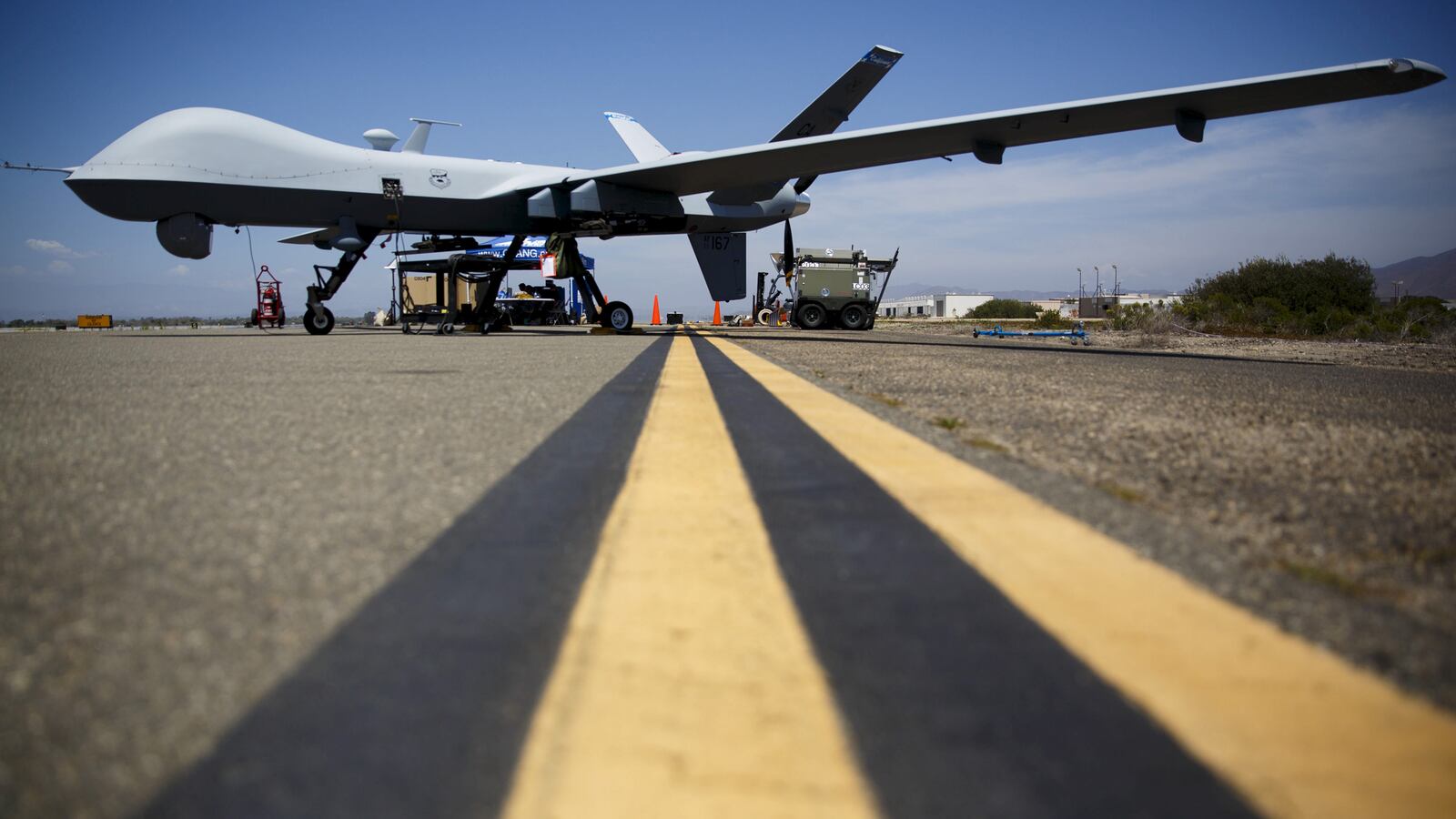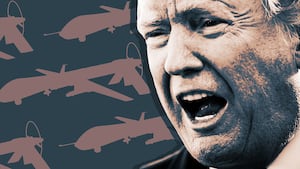When Houthi fighters blasted an American drone out of the sky in Yemen last month, it raised questions about what exactly the U.S. Reaper was doing there. U.S. officials say the drone was flying over Yemen as part of a terrorist-hunting mission. But that’s not the only thing America’s eyes in Yemen’s skies are up to. Over the past years, American drones have taken on more missions in the country.
U.S. officials tell The Daily Beast that American drones have been used to help warn Saudi Arabia about Houthi ballistic missile and drone launches at civilian targets in the kingdom; to monitor Houthi attacks on shipping in the Red Sea; and to support United Arab Emirates special operations forces pursuing al Qaeda targets. The U.S. has also offered to carry out drone flights to monitor a U.N.-backed ceasefire around Yemen’s Hodeida province.
Welcome to Rabbit Hole.
American drones involved in those missions aren’t supposed to fire on Houthi targets or provide targeting information to the Saudi-led coalition, sources say. But the mission comes against the backdrop of growing U.S. military involvement in the country and its various conflicts over the past few years.
The U.S. has provided refueling, intelligence support, and weapons for the Saudi-led war against the Houthi movement in Yemen, leading to an outcry from international human rights groups and Democratic and Republican lawmakers who point to the mounting civilian toll of the Saudi-led war, which has killed 90,000 people, sparked widespread famine, and a cholera epidemic. And in just the first two years of the Trump administration, the number of U.S. drone strikes against al Qaeda targets have already surpassed those carried out throughout the entirety of President Obama’s two terms in office.
Counterterrorism: The U.S. Reaper drone shot down over Yemen in June, allegedly with the help of Iranian missile technology, “was supporting [counterterrorism] operations,” against ISIS and al Qaeda targets in Yemen, a Defense Department spokesperson told The Daily Beast.
Houthis outlets claimed the wreckage landed in the village of Zafran in Hodeida province, on Yemen’s Red Sea coast. The claims garnered little coverage at the time but a week later, when Iran allegedly attacked two petrochemical tankers in the Gulf of Oman, U.S. Central Command admitted that it had lost a Reaper drone in Yemen to a surface-to-air missile that “was enabled by Iranian assistance.”
That uptick in drone activity against al Qaeda targets has also lead the U.S. to support Emirati special operations forces with American drones. “The U.S. can also support UAE [special operations forces] when they are actioning on AQAP targets,” one U.S. government official told The Daily Beast, using the acronym for al Qaeda in the Arabian Peninsula. “The U.S. does not support them with UAVs in going after Houthi targets.” U.S. drones help gather intelligence to plan attacks on al Qaeda targets, the official added.
The unique support that U.S. drones offer to Emirati forces is likely a reflection both of Emirati special operations forces’ close relationships with their American counterparts and their focus on operations against al Qaeda in Yemen. U.S. and Emirati special operations forces have worked closely together for years, a relationship that includes an Emirati deployment of troops to Afghanistan and a joint January 2017 raid against an al Qaeda target in Yemen that lead to the death of a U.S. Navy SEAL. Within the Saudi-led coalition in Yemen, Emirati forces have maintained a close focus on counterterrorism operations against al Qaeda.
The U.S. briefly withdrew its own special operations forces from Yemen after the beginning of the civil war there but Emirati troops have maintained a presence and a focus on counterterrorism operations, even amid a planned partial pullout from the country. “Their counterterrorism operations are primarily taking place in Al Bayda province,” in the south of the country where AQAP has a heavy presence, Elana DeLozier, a research fellow at the Washington Institute for Near East Policy, told The Daily Beast.
Early warning: The introduction of Iranian missile and drone technology, however, has lead the Trump administration to deepen the involvement of U.S. drones in Yemen’s conflict. In addition to the longstanding counterterrorism missions, another U.S. official said American drones also provide early warning to Saudi Arabia of incoming Iranian-made ballistic missiles and suicide drones launched by Houthi forces in Yemen.
The New York Times first reported in 2018 that the Trump administration had sent special operations forces and spy planes to the Saudi border with Yemen to support a missile-hunting mission.
Houthi forces began to launch short range ballistic missiles against the Saudi capital of Riyadh, Jizan, Taif, and Jeddah beginning in 2017. In addition to the missiles, Houthi militants have also used Iranian-made, explosive-laden kamikaze drones to attack an airport in Abha, Saudi Arabia, and oil facilities in Jizan. Ever since the U.S. warned that Iran was planning a renewed campaign of harassment against the U.S. and its allies in the Gulf in early May, Houthi forces have dramatically ramped up missile and drone attacks against targets inside the kingdom and revealed a new cruise missile in a strike against a water purification facility on the Saudi Red Sea coast.
Red Sea eyes: In addition to the ballistic missile launches aimed at Saudi Arabia, American drones have also long kept an eye out for Houthi attacks against ships in the Red Sea. “Houthis occasionally shoot at commercial ships in the Bab al Mandab, so some of the [intelligence, surveillance, and reconnaissance] is to counter that. The drones are there for maritime security and freedom of navigation,” the first U.S. official said.
Houthi forces targeted U.S. Navy and Saudi vessels in the Red Sea with anti-ship missiles in 2016. The Obama administration responded to an attack on U.S. Navy ships with a cruise missile strike against Houthi missile radar installations. But the attack didn’t stop Houthi forces from attacking shipping targets in international waters. In May 2018, a missile slammed into a Turkish ship carrying wheat to Yemen in the Red Sea in what some believe was an attack by Houthi forces and two months later, Houthi missiles targeted Saudi oil tankers in the Bab al Mandab.
Peacekeepers: The U.S. has also floated the possibility of using its drones to try to support a nascent peace deal among the Yemeni civil war’s belligerents.
An official said the U.S. has made its drones available in support of the UN to “guarantee the conditions of ceasefires” around Hodeida in Yemen. In December 2018, Houthi militants and representatives of the Saudi-led coalition agreed to a peace plan in Stockholm, Sweden, which would include Houthi withdrawals from Yemen’s port city of Hodeida, a ceasefire, and the creation of demilitarized zones along the Red Sea coast to facilitate trade and humanitarian aid shipments. Another source familiar with the U.S. offer said the prospect of a role for American drones in ceasefire monitoring led some to strongly argue against the offer due to concerns that it could degrade confidence in the UN’s neutrality.
Some officials were reportedly skeptical because the move would lend an air of neutrality to a mission carried out by the U.S., which has hardly been neutral between the Saudi-led coalition and Houthi fighters in Yemen’s civil war. Suspicions about what American drones would do with intelligence collected on the missions—whether it could be shared with the Saudi-led coalition and later used for targeting purposes—further stoked opposition to the proposal.
It’s unclear if the U.N. embraced the American offer. The U.N. Secretary-General’s office wouldn’t confirm the drone offer or whether flights had taken place in support of it. A spokesperson would only say that arrangements for ceasefire implementation were still being worked on and that the U.N. “could not comment at this stage.”
—with additional reporting by Erin Banco









